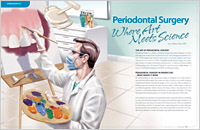Gum recession is a progressive dental condition in which the gum tissue pulls away from the teeth, gradually exposing the root. There are several possible causes, including plaque buildup, aggressive brushing, misaligned teeth and periodontal disease. While the condition itself isn’t typically painful, it can leave exposed roots open to decay, which can ultimately result in tooth loss.
As to whether it’s possible to reverse the condition, it is not currently possible to make the gums grow back over the area without surgery. The reason for this is that when gums recede, the bone beneath them also recedes and is often destroyed by the infection. The objectives of treatment are to stop the progression, cover the roots through surgical procedures, and establish a proper dental care regimen to control the bacteria that cause the condition.
In mild cases of gum recession, gums or teeth may become sensitive, making it difficult to clean away plaque. Treatment usually involves a deep cleaning of the periodontal pockets (called tooth scaling and root planing) to remove plaque and tartar buildup, both above and below the gum line. The patient may also be given antibiotics to kill remaining bacteria and instructed on how to brush their teeth in a way that doesn’t aggravate the gums. Desensitizing toothpaste is often recommended.
Break down biofilm with PerioRenew
Unhealthy gums can dramatically impact more than just your smile. Learn more about this revolutionary new gel for gum disease.
sponsored ad
The most common treatment for severe gum recession involves grafting a piece of skin from another part of the mouth (such as the roof of the mouth) to cover exposed root surfaces and reinforce the remaining tissue. This can be performed around as many teeth as is necessary. In some cases, synthetic or freeze-dried tissue can be used. This procedure can last for a lifetime, provided the patient takes proper care of the area.
Severe gum recession might require bone grafting in areas where there has been so much decay that there’s nothing left to support a soft-tissue graft. In such a case, bone from the patient’s own body is preferred. If this is not possible, freeze-dried bone from a tissue bank or mineral bone substitutes can be used.
For those with healthier teeth and gums, there are other surgical options. One involves drilling small holes in the teeth and filling them with a substance that will keep the gums from withdrawing any further. Another method being studied (not yet approved by the American Dental Association) involves roughening the surface of the affected teeth with a dental drill and applying filler material. This is usually done a couple of times, while using high-intensity blue light to cure each layer of the material.
Most of these procedures will stop continued deterioration of affected teeth and gums, but none can reverse the damage that’s already been done. Additionally, none of these treatments will help if the patient neglects brushing, flossing and following any other recommendations from their dentist. Note that proper dental hygiene and regular dental visits are the best way to maintain good oral health.
 Periodontal Surgery – Where Art Meets Science
Periodontal Surgery – Where Art Meets Science
This article is an overview of how the art of plastic surgical procedures and the science of periodontics can enhance the health and beauty of your teeth. You will learn what periodontal surgery is designed to do, what makes it successful and what to expect during treatment… Read Article
 Periodontal Plastic Surgery
Periodontal Plastic Surgery
Millions of Americans have some degree of gum recession — a loss of the tough, pink tissue that surrounds teeth. Receding gums can cause anything from minor tooth sensitivity to tooth loss in very severe cases. Fortunately, the field of periodontal plastic surgery has made enormous strides in devising techniques, including grafting, to deal with the problem of lost or damaged gum tissue… Read Article

